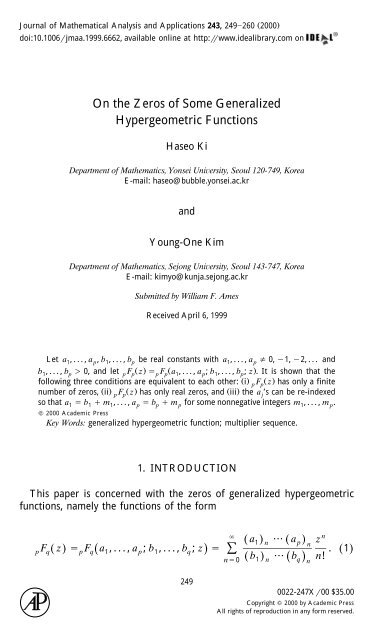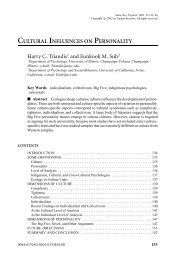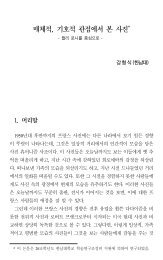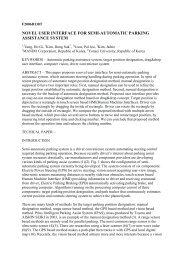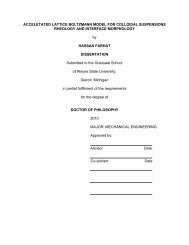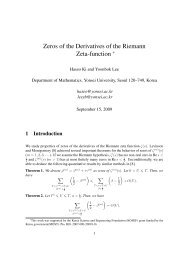On the Zeros of Some Generalized Hypergeometric Functions
On the Zeros of Some Generalized Hypergeometric Functions
On the Zeros of Some Generalized Hypergeometric Functions
You also want an ePaper? Increase the reach of your titles
YUMPU automatically turns print PDFs into web optimized ePapers that Google loves.
Journal <strong>of</strong> Ma<strong>the</strong>matical Analysis and Applications 243, 249260 Ž 2000.<br />
doi:10.1006jmaa.1999.6662, available online at http:www.idealibrary.com on<br />
<strong>On</strong> <strong>the</strong> <strong>Zeros</strong> <strong>of</strong> <strong>Some</strong> <strong>Generalized</strong><br />
<strong>Hypergeometric</strong> <strong>Functions</strong><br />
Haseo Ki<br />
Department <strong>of</strong> Ma<strong>the</strong>matics, Yonsei Uniersity, Seoul 120-749, Korea<br />
E-mail: haseo@bubble.yonsei.ac.kr<br />
and<br />
Young-<strong>On</strong>e Kim<br />
Department <strong>of</strong> Ma<strong>the</strong>matics, Sejong Uniersity, Seoul 143-747, Korea<br />
E-mail: kimyo@kunja.sejong.ac.kr<br />
Submitted by William F. Ames<br />
Received April 6, 1999<br />
Let a 1,...,a p, b 1,...,bp be real constants with a 1,...,a p 0, 1, 2, . . . and<br />
b ,...,b 0, and let F Ž z. F Ž a ,...,a ; b ,...,b ; z .<br />
1 p p p p p 1 p 1 p . It is shown that <strong>the</strong><br />
following three conditions are equivalent to each o<strong>the</strong>r: Ž. i F Ž z. p p has only a finite<br />
number <strong>of</strong> zeros, Ž ii. F Ž z. has only real zeros, and Ž iii. <strong>the</strong> a ’s can be re-indexed<br />
p p j<br />
so that a b m ,...,a b m for some nonnegative integers m ,...,m .<br />
1 1 1 p p p 1 p<br />
2000 Academic Press<br />
Key Words: generalized hypergeometric function; multiplier sequence.<br />
1. INTRODUCTION<br />
This paper is concerned with <strong>the</strong> zeros <strong>of</strong> generalized hypergeometric<br />
functions, namely <strong>the</strong> functions <strong>of</strong> <strong>the</strong> form<br />
<br />
n<br />
Ž a1. n Ž ap . z n<br />
F Ž z. F Ž a ,...,a ; b ,...,b ; z. Ý<br />
. Ž 1.<br />
b b n!<br />
p q p q 1 p 1 q<br />
249<br />
Ž . Ž .<br />
n0 1 n q n<br />
0022-247X00 $35.00<br />
Copyright 2000 by Academic Press<br />
All rights <strong>of</strong> reproduction in any form reserved.
250<br />
KI AND KIM<br />
Here a ,...,a and b ,...,b Ž 0, 1, 2, . . . . are constant and Ž a. 1 p 1 q n<br />
Ž a n. Ž a . , that is,<br />
Ž a. 0 1 and Ž a. n aŽ a1. Ž a n 1. Ž n 1,2,... . .<br />
Observe that we must assume b 1,...,b10, 1, 2, . . . in order that <strong>the</strong><br />
series may be well defined, and that <strong>the</strong> series reduces to a polynomial<br />
whenever some aj is equal to 0 or a negative integer.<br />
In 1929, Hille published a paper entitled Note on some hypergeometric<br />
series <strong>of</strong> higher order 3 . In this paper, he studied <strong>the</strong> zeros <strong>of</strong> <strong>the</strong> series Ž. 1<br />
in <strong>the</strong> case where p q and <strong>the</strong> parameters a 1,...,a p and b 1,...,bq are<br />
real. ŽNote that Ž 1. defines an entire function if and only if p q,<br />
provided a ,...,a 0, 1, 2, . . . . . In particular, he proved that Ž i. 1 p<br />
if<br />
a 0, 1, 2, . . . , <strong>the</strong> necessary and sufficient condition for F Ž a; b; z.<br />
1 1<br />
to have only a finite number <strong>of</strong> zeros is that a b is a non-negative<br />
integer, and that Ž ii. if b 1,...,bp 0 and m 1,...,m p are non-negative<br />
integers, <strong>the</strong>n F Ž b m ,...,b m ; b ,...,b ; z. p p 1 1 p p 1 p has real zeros only.<br />
He proved Ž ii. in <strong>the</strong> special case where m1 m p,<br />
but <strong>the</strong> same<br />
method yields <strong>the</strong> general case.<br />
The purpose <strong>of</strong> this paper is to generalize Hille’s results mentioned<br />
above. For convenience, we introduce <strong>the</strong> following three conditions on<br />
F Ž a ,...,a ; b ,...,b ; z . .<br />
p p 1 p 1 p<br />
F. F Ž a ,...,a ; b ,...,b ; z. p p 1 p 1 p has only a finite number <strong>of</strong> zeros.<br />
R. F Ž a ,...,a ; b ,...,b ; z. has only real zeros.<br />
p p 1 p 1 p<br />
I. The a ’s can be re-indexed so that a b m ,...,a b m<br />
j 1 1 1 p p p<br />
for some non-negatie integers m ,...,m .<br />
1 p<br />
What Hille has proved are Ž. i if p 1 and a1 0, 1, 2, . . . , <strong>the</strong>n F<br />
and I are equivalent, and Ž ii. if b ,...,b 0, <strong>the</strong>n I implies R. In this<br />
1 p<br />
paper, we first consider <strong>the</strong> general case when <strong>the</strong> parameters a 1,...,a p<br />
and b 1,...,bq are allowed to have complex values, and prove that if<br />
a ,...,a 0, 1, 2, . . . , <strong>the</strong>n F and I are equivalent Ž<br />
1 p<br />
Theorem 1,<br />
Section 2 . . Next, in Section 3, we apply a method due to Barnes to show<br />
that F Ž z. is a real entire function and a ,...,a are real, <strong>the</strong>n F Ž z. p p 1 p p p has<br />
only a finite number <strong>of</strong> real zeros Ž Theorem 2 . . As a result <strong>of</strong> Theorem 1<br />
and Theorem 2 we obtain Theorem 3 which states that if a ,...,a<br />
1 p<br />
Ž 0, 1, 2, . . . . are real and b 1,...,bp 0, <strong>the</strong>n F, R, and I are<br />
equivalent to each o<strong>the</strong>r. Finally, we conclude this paper with some<br />
examples which show that <strong>the</strong> assumptions in our <strong>the</strong>orems cannot be<br />
weakened Ž Section 4 . .
ZEROS OF GENERALIZED HYPERGEOMETRIC FUNCTIONS 251<br />
2. NUMBER OF ZEROS<br />
In this section, we will prove <strong>the</strong> following <strong>the</strong>orem.<br />
THEOREM 1. If a ,...,a 0, 1, 2,..., <strong>the</strong>n F and I are equialent.<br />
1 p<br />
Pro<strong>of</strong>. We first prove that I implies F. Let denote <strong>the</strong> differential<br />
Ž . n<br />
operator zddz , so that for each convergent power series Ý Anz and a<br />
constant a we have<br />
<br />
Ý Ž . n<br />
n Ž<br />
<br />
. Ý n<br />
n<br />
n0 n0<br />
a n A z a A z .<br />
If b 0, 1, 2, . . . and m is a non-negative integer, <strong>the</strong>n<br />
1F1Ž bm; b; z.<br />
<br />
Ý<br />
n0<br />
Ž b m. n<br />
n z<br />
Ž b. n n!<br />
<br />
n<br />
1 z<br />
Ý<br />
Ž b n.Ž b1n. Ž b m 1 n.<br />
Ž b. m n0<br />
n!<br />
n<br />
1 z<br />
Ž b .Ž b 1 . Ž b m 1 . Ý ,<br />
Ž b. m n0 n!<br />
Ž . Ž . z so that F bm; b; z P z e for some polynomial PŽ z. 1 1<br />
<strong>of</strong> degree m.<br />
In general, if b 1,...,bp 0, 1, 2, . . . and m 1,...,m p are non-negative<br />
integers, <strong>the</strong>n we have<br />
pFpŽ b1m 1,...,bpm p; b 1,...,b p;<br />
z.<br />
m 1 n<br />
p j <br />
1 z<br />
Ł Ł Ž bj k . Ý ,<br />
b n!<br />
Ž .<br />
j1 j m k0<br />
n0<br />
j<br />
Ž . Ž . z<br />
and hence pFp b1m 1,...,bpm p; b 1,...,b p;<br />
z P z e for some<br />
polynomial PŽ z. <strong>of</strong> degree m1 m p.<br />
This proves that I implies F.<br />
Conversely, suppose that a ,...,a 0, 1, 2, . . . and that F Ž z. 1 p p p <br />
F Ž a ,...,a ; b ,...,b ; z. p p 1 p 1 p has only a finite number <strong>of</strong> zeros. Then<br />
F Ž z. p p is an entire function <strong>of</strong> order 1 with finitely many zeros. Therefore<br />
F Ž z. can be written in <strong>the</strong> form<br />
p p<br />
Ž .<br />
F z c cz c zN e z Ž . , Ž 2.<br />
p p 0 1 N
252<br />
KI AND KIM<br />
where , c ,...,c are constants with , c 0. It is well known 1, p. 60<br />
0 N N<br />
and easy to see that F Ž z. satisfies <strong>the</strong> differential equation<br />
p p<br />
d<br />
Ž b1 1. Ž bp 1. Ž a1. Ž ap. pFpŽ z. 0.<br />
dz<br />
Ž 3.<br />
Ž. Ž.<br />
From 2 and 3 , we obtain<br />
p1 p c z Np lower terms 0,<br />
Ž . N<br />
Ž.<br />
so that 0 or 1. Since 0, it follows that 1, and hence 2<br />
becomes<br />
Ž a . Ž a . z z<br />
c cz c z .<br />
n n<br />
1 n p n N<br />
Ý Ž 0 1 N . Ý<br />
n0 Ž b1. n Ž bp. n! n0 n!<br />
n<br />
Therefore we have<br />
Ž a1. n Ž ap . 1 c0 c1 c<br />
n N<br />
<br />
Ž b . b n! n! Ž n 1 . ! Ž n N . !<br />
Ž .<br />
1 n p n<br />
Ž.<br />
Let f t be <strong>the</strong> polynomial defined by<br />
Ž n N, N 1,... . . Ž 4.<br />
fŽ t. c0ct 1 c2tŽ t1. cNtŽ t1. Ž t N 1 . .<br />
Ž.<br />
Then 4 implies that<br />
and hence we have<br />
Ž a1. n Ž ap<br />
. n<br />
fŽ n. Ž nN, N 1,... . ,<br />
b b<br />
Ž . Ž .<br />
1 n p n<br />
Ž a n. Ž a n. Ž a n. Ž a n. Ž a1. Ž ap<br />
.<br />
fŽ n. <br />
Ž b n. b n Ž b n. b n Ž b . b<br />
1 p 1 p n n<br />
Ž . Ž . Ž .<br />
1 p 1 p 1 n p n<br />
Ž a1. n1 Ž ap<br />
. n1<br />
fŽ n1. b b<br />
Ž . Ž .<br />
1 n1 p n1<br />
Ž n N, N 1,... .<br />
,
so that<br />
ZEROS OF GENERALIZED HYPERGEOMETRIC FUNCTIONS 253<br />
Ž .<br />
Ž a n. Ž a n. fŽ n. Ž b n. b n fŽ n1. 1 p 1 p<br />
Ž. Ž.<br />
Since f t is a polynomial, Eq. 5 implies that<br />
Ž . Ž .<br />
Ž n N, N 1, ... . . Ž 5.<br />
Ž a t. a t fŽ t. Ž b t. b t fŽ t1 . . Ž 6.<br />
1 p 1 p<br />
Now, using Ž. 6 and an induction, we will show that we can re-index<br />
a 1,...,a p so that a1b 1,...,a pbp are non-negative integers. If p N<br />
p deg fŽ. t 1, <strong>the</strong>n we must have p 1 and N 0, so that our<br />
assertion is trivial.<br />
Let p N 1 and assume <strong>the</strong> induction hypo<strong>the</strong>sis. Since b1 t is a<br />
factor <strong>of</strong> <strong>the</strong> right-hand side <strong>of</strong> Ž. 6 , it is a factor <strong>of</strong> <strong>the</strong> left-hand side also.<br />
Therefore b t divides Ž a t. Ž a t . ,orb t divides fŽ t .<br />
1 1 p 1<br />
.<br />
If b t divides Ž a t. Ž a t .<br />
1 1 p , <strong>the</strong>n b1 ak for some k. Re-index<br />
a ,...,a so that a b . Then Ž. 6 implies that<br />
1 p 1 1<br />
Ž . Ž .<br />
Ž a t. a t fŽ t. Ž b t. b t fŽ t1 . .<br />
2 p 2 p<br />
Hence, by <strong>the</strong> induction hypo<strong>the</strong>sis, we can re-index a ,...,a so that<br />
2 p<br />
a b ,...,a b are non-negative integers.<br />
2 2 p p<br />
If b t divides fŽ. t , <strong>the</strong>n <strong>the</strong>re is a polynomial f Ž.<br />
1 1 t <strong>of</strong> degree N 1<br />
such that fŽ. t Ž b t. f Ž. t . From Ž. 6 , we obtain<br />
1 1<br />
Ž . Ž .<br />
Ž a t. a t f Ž t. Ž b t. b t fŽ t1. 1 p 1 2 p<br />
Ž .<br />
Ž b t. b t Ž b t 1. f Ž t1 . .<br />
2 p 1 1<br />
Again, <strong>the</strong> induction hypo<strong>the</strong>sis implies that we can re-index a ,...,a<br />
1 p<br />
so that a b 1, a b ,...,a b are non-negative integers. This<br />
1 1 2 2 p p<br />
proves our assertion.<br />
3. REALITY OF ZEROS<br />
We start this section with an asymptotic equality due to Barnes 1 . Let<br />
a 1,...,a p and b 1,...,bp be complex constants and assume that b 1,...,bp 0, 1, 2, . . . . In 1, pp. 8083 ,<br />
it is shown that for each 0we
254<br />
have<br />
p Ž a .<br />
KI AND KIM<br />
j<br />
Ł p p 1 p 1 p<br />
j1 Ž bj<br />
.<br />
F Ž a ,...,a ; b ,...,b ; z.<br />
ž ž / /<br />
ž /<br />
1 <br />
z Ýa jÝb ez j 1 O z, arg z . Ž 7.<br />
z 2<br />
Here arg is <strong>the</strong> principal branch <strong>of</strong> <strong>the</strong> argument. Hence F Ž z. p p has only a<br />
<br />
finite number <strong>of</strong> zeros in <strong>the</strong> sector arg z 2 for each 0.<br />
Next, we will show that if<br />
Ž a1. n Ž ap<br />
. n<br />
Ž n 0,1,2,... . ,<br />
b b<br />
Ž . Ž .<br />
1 n p n<br />
and if a ,...,a are real, <strong>the</strong>n F Ž z. 1 p p p has only a finite number <strong>of</strong> negative<br />
real zeros. If some a is equal to zero or a negative integer, <strong>the</strong>n F Ž z. j p p is a<br />
polynomial, and if <strong>the</strong> condition I holds, <strong>the</strong>n F Ž z. p p has only a finite<br />
number <strong>of</strong> zeros, by Theorem 1. Hence we may assume, without loss <strong>of</strong><br />
generality, that a 1,...,a p 0, 1, 2, . . . and that <strong>the</strong> condition I does<br />
not hold. Then <strong>the</strong> function Ž a s. Ž a s. Ž b s. Ž 1 p 1 bp <br />
s. has infinitely many poles all <strong>of</strong> which are different from 0, 1, 2, . . . . Let<br />
, , . . . denote <strong>the</strong> distinct poles <strong>of</strong> Ž a s. Ž a s. Ž 1 2 1 p b1 <br />
s. Ž b s . . For each k 1, 2, . . . let R Ž z. p k denote <strong>the</strong> residue <strong>of</strong> <strong>the</strong><br />
function<br />
Ž a s. Ž a s.<br />
Ž s.Ž z.<br />
b s b s<br />
1 p s<br />
Ž . Ž .<br />
1 p<br />
Ž . s<br />
at <strong>the</strong> pole s . Here z is defined by<br />
k<br />
s<br />
z exp s log z<br />
Ž . Ž .<br />
for s and z 0; log is <strong>the</strong> principal branch <strong>of</strong> <strong>the</strong> logarithm. Then it<br />
Ž . Ž . is easy to see that R z z k is a polynomial <strong>of</strong> logŽ z. k<br />
for each<br />
k 1, 2, . . . . See 6, p. 288 also.<br />
Let A max Ima : j 1,..., p 4<br />
j<br />
, let K be an arbitrary positive real<br />
number such that Re k K for all k 1, 2, . . . , and let C1 denote <strong>the</strong><br />
contour composed <strong>of</strong> <strong>the</strong> half line s t Ai, t K, <strong>the</strong> line<br />
segment from K Ai to K Ai, and <strong>the</strong> half line s t Ai, K t
ZEROS OF GENERALIZED HYPERGEOMETRIC FUNCTIONS 255<br />
. Then we have<br />
1 Ž a1 s. Ž aps. s<br />
H<br />
Ž s.Ž z. ds<br />
2 i b s b s<br />
Ž . Ž .<br />
C1 1 p<br />
Ž a1. Ž ap<br />
.<br />
pFpŽ z. Ý RkŽ z.<br />
b b<br />
Ž . Ž .<br />
1 p K k<br />
for Re z 0.<br />
Let C2 denote <strong>the</strong> line s K it, t , and let 0be<br />
<br />
arbitrary. If argŽ z.Im logŽ z. , <strong>the</strong>n<br />
Moreover, we have<br />
so that<br />
Ž a1 s. Ž aps. s<br />
H Ž s.Ž z. ds<br />
b s b s<br />
Ž . Ž .<br />
C1 1 p<br />
Ž a1 s. Ž aps. s<br />
H Ž s.Ž z. ds.<br />
b s b s<br />
Ž . Ž .<br />
C2 1 p<br />
Ž a s. Ž a s.<br />
H s z dsO z b s b s<br />
1 p s K<br />
Ž . Ž .<br />
C2 1 p<br />
Ž a . Ž a .<br />
2<br />
Ž .Ž . Ž .<br />
ž /<br />
<br />
argŽ z. , z ,<br />
2<br />
Ž . Ý Ž . Ž .<br />
1 p<br />
pFp z Rk z O<br />
K z 1 p K k<br />
Ž . Ž .<br />
b b<br />
ž /<br />
<br />
argŽ z. , z . Ž 8.<br />
2<br />
From Ž. 8 , it follows that if a ,...,a are real and if R Ž z. 1 p k 0 for some<br />
k and z, <strong>the</strong>n for each 0 <strong>the</strong> function F Ž z. p p has only a finite number<br />
<strong>of</strong> zeros in <strong>the</strong> sector argŽ z. , because R Ž z. Ž z . 1,<br />
R Ž z. 2<br />
1 2 <br />
Ž . z 2, . . . are polynomials <strong>of</strong> logŽ z . .<br />
Remark. It seems hardly true that R Ž z. k 0 for all k and z, but <strong>the</strong><br />
authors were unable to prove that this is not <strong>the</strong> case.<br />
To proceed fur<strong>the</strong>r, we need <strong>the</strong> following lemma whose pro<strong>of</strong> is almost<br />
trivial.
256<br />
KI AND KIM<br />
LEMMA. Let fŽ s. be a function which has a pole <strong>of</strong> order m 1 at<br />
s , and let c ,...,c be arbitrary constants. Then ei<strong>the</strong>r fŽ s. 1 m1<br />
has<br />
nonzero residue at s or <strong>the</strong>re is a positie integer l m 1 such that<br />
Ž s c . Ž s c . fŽ s. has nonzero residue at s .<br />
1 l<br />
From this lemma, it follows that if z 0, <strong>the</strong>n for each k 1, 2, . . .<br />
<strong>the</strong>re is a nonnegative integer l such that <strong>the</strong> residue <strong>of</strong><br />
Ž a s. Ž a s.<br />
Ž s l.Ž z.<br />
b s b s<br />
1 p s<br />
Ž . Ž .<br />
1 p<br />
at s is not equal to zero. As a consequence, <strong>the</strong>re is a non-negative<br />
k<br />
integer l such that if z 0, <strong>the</strong>n <strong>the</strong> function<br />
Ž . Ž .<br />
Ž . Ž .<br />
a l s a l s<br />
1 p s<br />
b l s b l s<br />
1 p<br />
Ž s.Ž z.<br />
has a pole o<strong>the</strong>r than 0, 1, 2, . . . at which <strong>the</strong> residue is not equal to zero.<br />
Since<br />
F Žl. p p Ž a 1,...,a p; b 1,...,b p;<br />
z.<br />
Ž a1. l Ž ap<br />
. l<br />
pFpŽ a1l,...,a p l; b1 l,...,bp l; z . ,<br />
b b<br />
Ž . Ž .<br />
1 l p l<br />
we conclude that if a ,...,a are real, <strong>the</strong>n some derivative <strong>of</strong> F Ž z. 1 p p p has<br />
<br />
only a finite number <strong>of</strong> zeros in <strong>the</strong> sector argŽ z. 2 for each<br />
0.<br />
Now suppose that a ,...,a are real and that F Ž z. 1 p p p is a real entire<br />
function, that is, its Maclaurin coefficients are all real. Then <strong>the</strong> above<br />
Žl. argument implies that <strong>the</strong>re is a non-negative integer l such that F Ž z.<br />
p p<br />
has only a finite number <strong>of</strong> negative real zeros, and hence Rolle’s <strong>the</strong>orem<br />
implies that F Ž z. p p must have a finite number <strong>of</strong> negative real zeros. <strong>On</strong><br />
<strong>the</strong> o<strong>the</strong>r hand, Eq. Ž. 7 implies that F Ž z. p p has finitely many positive real<br />
zeros. Consequently, F Ž z. has only a finite number <strong>of</strong> real zeros.<br />
p p<br />
THEOREM 2. Suppose that F Ž z. p p is a real entire function and a 1,...,a p<br />
are real. Then F Ž z. has only a finite number <strong>of</strong> real zeros.<br />
p p<br />
COROLLARY. If F Ž z. p p is a real entire function and a 1,...,a p are real,<br />
<strong>the</strong>n R implies F.<br />
As mentioned in <strong>the</strong> Introduction, Hille proved that if b ,...,b 0,<br />
1 p<br />
<strong>the</strong>n I implies R, but he gave only a sketch <strong>of</strong> <strong>the</strong> pro<strong>of</strong>. For completeness,
ZEROS OF GENERALIZED HYPERGEOMETRIC FUNCTIONS 257<br />
we will give a detailed pro<strong>of</strong> <strong>of</strong> <strong>the</strong> result. Our pro<strong>of</strong> is based on <strong>the</strong><br />
PolyaSchur ´ <strong>the</strong>ory <strong>of</strong> multiplier sequences.<br />
4 A sequence <strong>of</strong> real numbers is said to be a multiplier sequence Ž<br />
nn0<br />
<strong>of</strong><br />
<strong>the</strong> first kind. if it has <strong>the</strong> following property.<br />
M. If a az a zd 0 1 d is a real polynomial with real zeros only,<br />
<strong>the</strong>n <strong>the</strong> polynomial<br />
also has real zeros only.<br />
a az a z d<br />
0 0 1 1 d d<br />
It follows immediately from <strong>the</strong> definition that if 4 and 4<br />
n n are<br />
multiplier sequences, <strong>the</strong>n <strong>the</strong>ir termwise product 4 n n is also a multi-<br />
plier sequence.<br />
The multiplier sequences are completely characterized by <strong>the</strong> following<br />
<strong>the</strong>orem <strong>of</strong> Polya ´ and Schur 4 .<br />
THE POLYASCHUR ´ THEOREM. A sequence 4 n <strong>of</strong> real numbers is a<br />
multiplier sequence if and only if <strong>the</strong> function<br />
<br />
n z<br />
Ž z. Ý n<br />
n0 n!<br />
can be uniformly approximated on compact sets in <strong>the</strong> complex plane by a<br />
sequence <strong>of</strong> real polynomials all <strong>of</strong> whose zeros are real and <strong>of</strong> <strong>the</strong> same sign.<br />
Let b be a positive real number. Then <strong>the</strong> PolyaSchur ´ <strong>the</strong>orem implies<br />
4 that b n is a multiplier sequence, because<br />
n0<br />
z z<br />
Ž b n. Ž z b. e lim Ž z b. 1 .<br />
n! k<br />
k<br />
n k<br />
z<br />
Ý ž /<br />
n0<br />
Since <strong>the</strong> class <strong>of</strong> multiplier sequences is closed under termwise multiplication,<br />
it follows that for each positive integer m <strong>the</strong> sequence<br />
<br />
Ž b n.Ž b1n. Ž b m 1 n. 4 n0<br />
is a multiplier sequence. Hence<br />
½ 5<br />
½ 5<br />
<br />
Ž b m. n<br />
1<br />
Ž b n.Ž b1n. Ž b m 1 n.<br />
Ž b. Ž b.<br />
n n0<br />
m n0<br />
is a multiplier sequence for each positive integer m.
258<br />
KI AND KIM<br />
Now suppose that b ,...,b are positive real numbers and m ,...,m<br />
1 p 1 p<br />
are nonnegative integers. Then it is clear that <strong>the</strong> sequence<br />
½ Ž b1m1. n Ž bpmp. 5 n<br />
Ž b . Ž b .<br />
1 n p n n0<br />
is a multiplier sequence. Hence, by <strong>the</strong> PolyaSchur ´ <strong>the</strong>orem, <strong>the</strong> function<br />
pFpŽ b1m 1,...,bpm p; b 1,...,b p;<br />
z.<br />
<br />
Ý<br />
Ž 1 1. Ž p p.<br />
Ž . Ž .<br />
b m b m z<br />
<br />
n n<br />
b b n!<br />
n0 1 n p n<br />
can be uniformly approximated on compact sets in <strong>the</strong> complex plane by a<br />
sequence <strong>of</strong> real polynomials all <strong>of</strong> whose zeros are real and <strong>of</strong> <strong>the</strong> same<br />
sign; in particular, it has only real zeros. This completes <strong>the</strong> pro<strong>of</strong>.<br />
THEOREM 3. If a ,...,a Ž 0, 1, 2, . . . .<br />
1 p are real and b 1,...,bp 0,<br />
<strong>the</strong>n F, R, and I are equialent.<br />
Pro<strong>of</strong>. We have just shown that if b ,...,b 0, <strong>the</strong>n I implies R.<br />
1 p<br />
Now, our <strong>the</strong>orem is an immediate consequence <strong>of</strong> Theorem 1 and <strong>the</strong><br />
corollary to Theorem 2.<br />
4. EXAMPLES<br />
In this section, we exhibit some examples which show that we cannot<br />
weaken <strong>the</strong> assumptions <strong>of</strong> <strong>the</strong> <strong>the</strong>orems in this paper without altering<br />
<strong>the</strong>ir conclusions. First <strong>of</strong> all, we remark that we must assume <strong>the</strong><br />
condition that a 1,...,a p 0, 1, 2, . . . in Theorem 1; o<strong>the</strong>rwise <strong>the</strong><br />
function F Ž a ,...,a ; b ,...,b ; z. p p 1 p 1 p reduces to a polynomial, so that <strong>the</strong><br />
implication F I does not hold.<br />
Theorem 2 states that if F Ž z. p p is a real entire function and a 1,...,a p<br />
are real, <strong>the</strong>n F Ž a ,...,a ; b ,...,b ; z. p p 1 p 1 p has only a finite number <strong>of</strong> real<br />
zeros. The following example, however, shows that this is not <strong>the</strong> case in<br />
general.<br />
Ž . Ž .<br />
EXAMPLE 1. The real entire function f z F i, i;1,1; z has in-<br />
2 2<br />
Ž.<br />
finitely many real zeros. This may be shown as follows. According to 8 <strong>of</strong><br />
n
ZEROS OF GENERALIZED HYPERGEOMETRIC FUNCTIONS 259<br />
<br />
Section 3 or <strong>the</strong> asymptotic equality given in 1, Sect. 9 , we have<br />
Ž . Ž . i 1<br />
2 i 2i<br />
f Ž t. t 1 OŽ t<br />
2<br />
.<br />
e e Ž 1 i.<br />
Ž .<br />
Ž . Ž . i 1<br />
i 2i<br />
t Ž 1 OŽ t . . ,<br />
2<br />
Ž 1 i.<br />
as t with t 0. Therefore <strong>the</strong>re exist real constants A and B, with<br />
A 0, such that<br />
f t A cos B log t O t1 Ž . Ž . Ž . Ž t , t 0 . ,<br />
and this proves our assertion.<br />
Next, we consider <strong>the</strong> assumptions <strong>of</strong> Theorem 3, namely a 1,...,a p <br />
0, 1, 2, . . . and b 1,...,bp 0. The following example is about <strong>the</strong><br />
condition a 1,...,a p 0, 1, 2, . . . .<br />
EXAMPLE 2. Let b 0. Then<br />
Ž x. <br />
Ž b.<br />
Ž b x.<br />
is a real entire function <strong>of</strong> order 1 and has negative real zeros only. Hence<br />
Ž . 14 Ž .4 b n is a complex zero decreasing sequence by <br />
n n0 n0<br />
2,<br />
Theorem 1.4 .<br />
In particular, it is a multiplier sequence. Let m be a positive<br />
Ž . 14 integer. If we apply <strong>the</strong> multiplier sequence b n n0to<br />
<strong>the</strong> polynomial<br />
Ž . m 1 z , <strong>the</strong>n we obtain F Ž m; b; z . , because<br />
1 1<br />
m n Ž m. z m<br />
n 1<br />
m n<br />
1 1Ž . Ý Ý ž n / Ž .<br />
n0 Ž b. n n! n0 Ž b.<br />
n<br />
F m; b; z z .<br />
Therefore F Ž m; b; z. 1 1<br />
has real zeros only for each m 1, 2, . . . and<br />
b 0. Consequently, we must assume a 1,...,a p 0, 1, 2, . . . in order<br />
to obtain <strong>the</strong> implication R I in Theorem 3.<br />
Our last example is concerned with <strong>the</strong> condition b 1,...,bp 0.<br />
EXAMPLE 3. Let b 0 and b 1, 2,... .If m is a positive integer<br />
greater than b, <strong>the</strong>n F Ž bm; b; z. has at least 2Ž 1 b. 2 1 1<br />
nonreal<br />
zeros.<br />
Pro<strong>of</strong>. Let m be a positive integer greater than b. Then Žb<br />
<br />
. 14 m n n0is<br />
a complex zero decreasing sequence. <strong>On</strong> <strong>the</strong> o<strong>the</strong>r hand, <strong>the</strong><br />
Ž . Ž . z<br />
pro<strong>of</strong> <strong>of</strong> Theorem 1 shows that F bm; b; z P z e for some real<br />
1 1
260<br />
KI AND KIM<br />
Ž .<br />
polynomial P z <strong>of</strong> degree m. Hence <strong>the</strong> number <strong>of</strong> nonreal zeros <strong>of</strong><br />
is at least that <strong>of</strong><br />
F Ž bm; b; z. Ý<br />
1 1<br />
<br />
n0<br />
Ž b m. n<br />
n z<br />
Ž b. n n!<br />
n n<br />
1 z 1 Ž b m. n z<br />
F Ž b; z. Ý Ý<br />
.<br />
Ž b. n! Ž b m. Ž b. n!<br />
0 1<br />
n0 n n0<br />
n n<br />
Now our assertion follows from a well-known <strong>the</strong>orem <strong>of</strong> Hurwitz 5, 15.27<br />
which states that if b 0 and b 1, 2, . . . , <strong>the</strong>n F Ž b; z. 0 1 has exactly<br />
2Ž 1b. 2 nonreal zeros.<br />
ACKNOWLEDGMENTS<br />
Pr<strong>of</strong>essor Askey informed us that Theorem 3 <strong>of</strong> this paper is not known. We truly thank<br />
him for this. Pr<strong>of</strong>essor Gasper conveyed many valuable facts to us. We thank him. We thank<br />
Pr<strong>of</strong>essor Csordas for pointing out <strong>the</strong> correct <strong>the</strong>orem on <strong>the</strong> complex zero decreasing<br />
sequences. In <strong>the</strong> original version <strong>of</strong> this paper, we asserted that R Ž z. k 0 for some k and<br />
z, and <strong>the</strong> referee pointed out that our pro<strong>of</strong> <strong>of</strong> this may be invalid. We deeply thank <strong>the</strong><br />
referee for this as well as for <strong>the</strong> valuable comments. The authors acknowledge <strong>the</strong> financial<br />
support <strong>of</strong> <strong>the</strong> Korea Research Foundation in <strong>the</strong> program year <strong>of</strong> Ž 19982000 . . The second<br />
author was supported by <strong>the</strong> Korea Science and Engineering Foundation Ž KOSEF. through<br />
<strong>the</strong> Global Analysis Research Center Ž GARC. at Seoul National University.<br />
REFERENCES<br />
1. E. W. Barnes, The asymptotic expansion <strong>of</strong> integral functions defined by generalised<br />
hypergeometric series, Proc. London Math. Soc. Ž 2. 5 Ž 1907 . , 59116.<br />
2. T. Craven and G. Csordas, Complex zero decreasing sequences, Methods Appl. Anal. 2<br />
Ž 1995 . , 420441.<br />
3. E. Hille, Note on some hypergeometric series <strong>of</strong> higher order, J. London Math. Soc. 4<br />
Ž 1929 . , 5054.<br />
4. G. Polya ´ and J. Schur, Uber ¨ zwei Arten von Faktorenfolgen in der Theorie der algebraischen<br />
Gleichungen, J. Reine Angew. Math. 144 Ž 1914 . , 89113.<br />
5. G. N. Watson, ‘‘Theory <strong>of</strong> Bessel <strong>Functions</strong>,’’ 2nd ed., Cambridge Univ. Press, London,<br />
1952.<br />
6. E. M. Wright, The asymptotic expansion <strong>of</strong> <strong>the</strong> generalized hypergeometric function, J.<br />
London Math. Soc. 10 Ž 1935 . , 286293.


